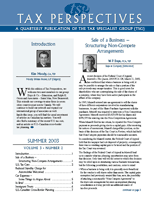
PDF Format
 Issue Contents Issue Contents
 All Issues All Issues
Summer 2003
Volume 3, Number 2
The information in Tax Perspectives is prepared for general interest only. Every effort has been made to ensure that the contents are accurate. However, professional advice should always be obtained before acting on the information herein.
U.S.-Canadian Cross-Border Planning — Nova Scotia Unlimited Liability Companies (Part 2)
By Steven Peters, CA, CPA, TEP
Steven Peters Limited (Halifax)
As you may recall from my article in the Spring 2002 edition of Tax Perspectives, a Nova Scotia unlimited liability company (NSULC) is a Nova Scotia company whose shareholders elect to have unlimited liability for corporate debts. One may wonder why on earth anyone would make such an election. The answer is that this election causes the NSULC to be treated as a flow-through entity for US tax purposes, such that a US shareholder of an NSULC reports its share of the NSULC's income and expenses directly on its US tax return. For Canadian tax purposes, an NSULC is treated just like any other Canadian corporation. This hybrid treatment provides a host of tax planning opportunities for US taxpayers owning Canadian businesses or investments. My previous article focused on two of the most obvious benefits for US shareholders of NSULC's. First, the NSULC enables US taxpayers to avoid double taxation — by permitting, on the shareholder's US return, a foreign tax credit for the underlying Canadian corporate income tax paid by the NSULC. Second, where the NSULC has losses, these may be deductible on the US return of its shareholder. This article will highlight some other tax advantages that NSULC's can provide, as follows: - Interest paid by Canadian company to US shareholder:
A loan to a wholly-owned NSULC from its US shareholder would be disregarded for US tax purposes. If properly structured, interest paid by the NSULC would be deductible by the NSULC for Canadian tax purposes but would not constitute income to the shareholder for US tax purposes. This may achieve a significant reduction in the overall tax rate. Planning such an arrangement must take into account the Canadian thin capitalization rules, which generally limit the deductibility of interest where the total debt to related non-residents exceeds twice the company's equity, and the 10% withholding tax that would apply to interest payments. - Acquisition of a Canadian corporation by a US purchaser:
In acquisition negotiations, the vendor and purchaser typically have conflicting interests regarding whether to sell shares or assets — because the vendor's tax on the sale will be lower if he sells shares, but the purchaser will want to buy assets to obtain an increase in the cost of the assets for tax purposes. However, conversion of the corporation to an NSULC may ameliorate this conflict, by allowing the vendor to sell shares while creating a bump to the cost of the corporate assets for US (but not Canadian) tax purposes. Proper structuring of such an acquisition may also include a loan to the NSULC creating interest as described above. - Avoidance of double taxation on transfer pricing adjustments:
The amount charged for goods and services between related parties must meet the arm's length standard for both US and Canadian tax purposes. However, determination of an arm's length charge is often difficult or impossible, leaving taxpayers vulnerable to transfer pricing adjustments by the IRS or CCRA. In a US parent — Canadian subsidiary scenario, such a transfer pricing adjustment exposes the US parent to double taxation unless the subsidiary is an NSULC.This can be illustrated by a simple example. Assume the US parent provides management services to the Canadian subsidiary, for which it charges a fee. Where the subsidiary is an ordinary Canadian corporation, the fee will create income to the parent company for US tax purposes. If CCRA were to reduce the amount of the fee that is deductible to the subsidiary, double taxation would arise unless the parent company can obtain a corollary reduction in its income inclusion (by consent of the IRS or recourse to the competent authority provisions of the Canada-US Tax Treaty). However, where the subsidiary is an NSULC, all transactions between it and the parent would be disregarded for US tax purposes; thus, the parent would not have an income inclusion for the fee charged to the NSULC, and a reduction in the deduction allowed to the NSULC by CCRA would not create double taxation. - Cross-border estate freeze:
Perhaps the most common estate planning device is an estate freeze, in which parents transfer appreciating assets to a freeze company so that future appreciation inures to their children. Where children live in the US however, an estate freeze will generally create disastrous US tax consequences to the children unless the freeze company is an NSULC. That is because, if the freeze company is an ordinary corporation, it will generally be a foreign personal holding company for US tax purposes, which then creates two big problems for the children living in the US: first, they will have to include in income annually their pro rata share of the income of the freeze company, and second, the common shares they own in the freeze company will not receive a step-up in tax basis for US purposes on the death of the parents. If the freeze company is an NSULC, foreign personal holding company characterization is avoided.
As you can see from the above examples, the NSULC has many uses in US-Canadian cross-border tax planning. In implementing an NSULC, the importance of proper planning cannot be overemphasized. The truism in tax planning — that the devil is in the details — is particularly critical where two tax jurisdictions are involved.
|




